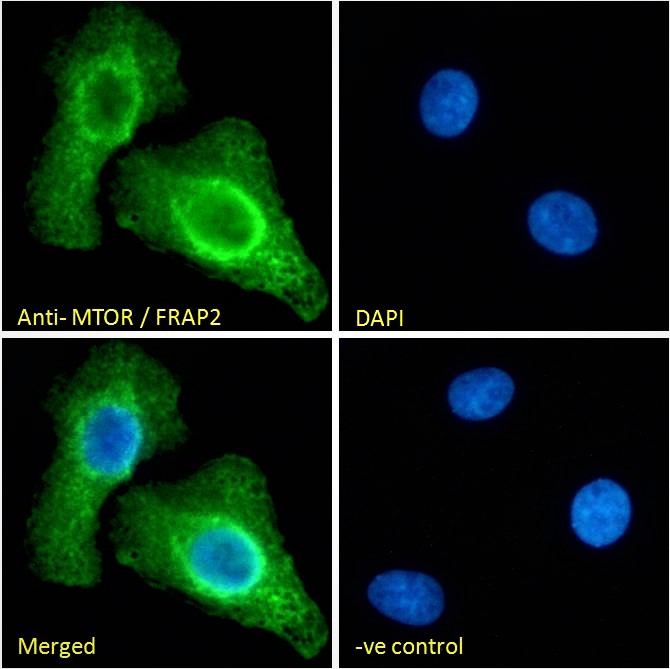mTOR antibody [C3], C-term
GTX101557
ApplicationsImmunoFluorescence, ImmunoPrecipitation, Western Blot, ChIP Chromatin ImmunoPrecipitation, ImmunoCytoChemistry, ImmunoHistoChemistry, ImmunoHistoChemistry Paraffin
Product group Antibodies
TargetMTOR
Overview
- SupplierGeneTex
- Product NamemTOR antibody [C3], C-term
- Delivery Days Customer9
- Application Supplier NoteWB: 1:500-1:3000. ICC/IF: 1:100-1:1000. IHC-P: 1:100-1:1000. IP: 1:100-1:500. *Optimal dilutions/concentrations should be determined by the researcher.Not tested in other applications.
- ApplicationsImmunoFluorescence, ImmunoPrecipitation, Western Blot, ChIP Chromatin ImmunoPrecipitation, ImmunoCytoChemistry, ImmunoHistoChemistry, ImmunoHistoChemistry Paraffin
- CertificationResearch Use Only
- ClonalityPolyclonal
- Concentration0.05 mg/ml
- ConjugateUnconjugated
- Gene ID2475
- Target nameMTOR
- Target descriptionmechanistic target of rapamycin kinase
- Target synonymsFRAP, FRAP1, FRAP2, RAFT1, RAPT1, SKS, serine/threonine-protein kinase mTOR, FK506 binding protein 12-rapamycin associated protein 2, FK506-binding protein 12-rapamycin complex-associated protein 1, FKBP-rapamycin associated protein, FKBP12-rapamycin complex-associated protein 1, mammalian target of rapamycin, mechanistic target of rapamycin (serine/threonine kinase), rapamycin and FKBP12 target 1, rapamycin associated protein FRAP2, rapamycin target protein 1, tyrosine-protein kinase mTOR
- HostRabbit
- IsotypeIgG
- Protein IDP42345
- Protein NameSerine/threonine-protein kinase mTOR
- Scientific DescriptionThe protein encoded by this gene belongs to a family of phosphatidylinositol kinase-related kinases. These kinases mediate cellular responses to stresses such as DNA damage and nutrient deprivation. This protein acts as the target for the cell-cycle arrest and immunosuppressive effects of the FKBP12-rapamycin complex. The ANGPTL7 gene is located in an intron of this gene. [provided by RefSeq]
- Storage Instruction-20°C or -80°C,2°C to 8°C
- UNSPSC12352203
References
- Dernovics Á, Seprényi G, Rázga Z, et al. Phenol-Soluble Modulin α3 Stimulates Autophagy in HaCaT Keratinocytes. Biomedicines. 2023,11(11). doi: 10.3390/biomedicines11113018Read this paper
- Wang J, Hua G, Chen J, et al. Epigenetic mechanism of Gtl2-miRNAs causes the primitive sheep characteristics found in purebred Merino sheep. Cell Biosci. 2023,13(1):190. doi: 10.1186/s13578-023-01142-zRead this paper
- Tian X, Wei Y, Hou R, et al. Yangqing Chenfei formula alleviates silica-induced pulmonary inflammation in rats by inhibiting macrophage M1 polarization. Chin Med. 2023,18(1):79. doi: 10.1186/s13020-023-00787-9Read this paper
- Duan S, Qin N, Pi J, et al. Antagonizing apolipoprotein J chaperone promotes proteasomal degradation of mTOR and relieves hepatic lipid deposition. Hepatology. 2023,78(4):1182-1199. doi: 10.1097/HEP.0000000000000185Read this paper
- Li M, Zhang W, Wang Y, et al. DDTC Suppresses Ovarian Cancer Development via the PI3K/AKT/mTOR Signaling Pathway. Dis Markers. 2022,2022:1941077. doi: 10.1155/2022/1941077Read this paper
- Ma YX, Jiao K, Wan QQ, et al. Silicified collagen scaffold induces semaphorin 3A secretion by sensory nerves to improve in-situ bone regeneration. Bioact Mater. 2022,9:475-490. doi: 10.1016/j.bioactmat.2021.07.016Read this paper
- Hashikawa-Hobara N, Otsuka A, Okujima C, et al. CGRP overexpression does not alter depression-like behavior in mice. PeerJ. 2021,9:e11720. doi: 10.7717/peerj.11720Read this paper
- Lee TY, Lu WJ, Changou CA, et al. Platelet autophagic machinery involved in thrombosis through a novel linkage of AMPK-MTOR to sphingolipid metabolism. Autophagy. 2021,17(12):4141-4158. doi: 10.1080/15548627.2021.1904495Read this paper
- Cheung CHY, Hsu CL, Lin TY, et al. ZNF322A-mediated protein phosphorylation induces autophagosome formation through modulation of IRS1-AKT glucose uptake and HSP-elicited UPR in lung cancer. J Biomed Sci. 2020,27(1):75. doi: 10.1186/s12929-020-00668-5Read this paper
- Li J, Ma J, Tian Y, et al. Effective-component compatibility of Bufei Yishen formula II inhibits mucus hypersecretion of chronic obstructive pulmonary disease rats by regulating EGFR/PI3K/mTOR signaling. J Ethnopharmacol. 2020,257:112796. doi: 10.1016/j.jep.2020.112796Read this paper




